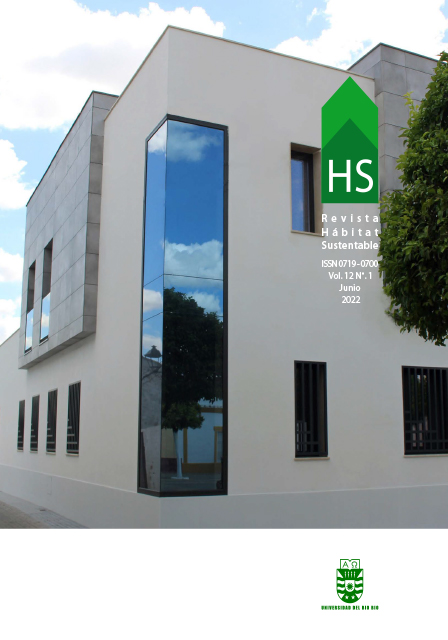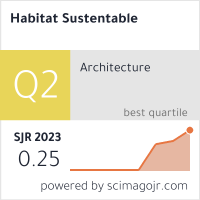Análisis cualitativo de sostenibilidad social de sistemas de drenaje urbano en Chile
DOI:
https://doi.org/10.22320/07190700.2022.12.01.03Palabras clave:
análisis cualitativo, desarrollo urbano, desarrollo sostenibleResumen
Avanzar hacia un desarrollo urbano sostenible conduce a aplicar nuevas formas de drenaje, las que entregan múltiples beneficios técnicos y sociales a la comunidad. No obstante, en países como Chile aún existe una gran brecha respecto de metodologías de evaluación de sostenibilidad social de proyectos de drenaje urbano. A través del análisis cualitativo de contenido aplicado a entrevistas a expertos (n = 11), este estudio busca (1) identificar métricas para la medición de la sostenibilidad social de sistemas de drenaje urbano; (2) identificar desafíos para la implementación de dichas métricas y (3) proponer modificaciones al método actual de evaluación de sistemas de drenaje para mejorar la inclusión de la sostenibilidad social en el primero. Dentro de los resultados se advirtió que expertos proponen métricas que capturan la sostenibilidad social, pero que, en la práctica, son complicadas de cuantificar. En términos de los desafíos, la fragmentación de responsabilidades de las organizaciones que participan de la gestión de sistemas de drenaje dificulta el uso de nuevas métricas de sostenibilidad social. Por último, se sugiere el desarrollo de una institución que pueda gestionar los sistemas de drenaje urbano de forma global e integral a fin de valorar los beneficios de la sostenibilidad social de sistemas de drenaje urbano. Estos resultados pueden ser utilizados por autoridades y tomadores de decisiones relacionados a sistemas de drenaje urbano para desarrollar nuevas metodologías que tomen en cuenta los beneficios de la sostenibilidad social.
Descargas
Citas
ANTHUN, K. S., MAASS, R. E. K., HOPE, S., ESPNES, G. A., BELL, R., KHAN, M. y LILLEFJELL, M. (2019). Addressing inequity: Evaluation of an intervention to improve accessibility and quality of a green space. International journal of environmental research and public health, 16(24). DOI: https://doi.org/10.3390/ijerph16245015
ARAYA, F., FAUST, K. M. y KAMINSKY, J. A. (2020). A decision-making framework for participatory planning: Providing water infrastructure services to displaced persons. En Construction Research Congress 2020: Infrastructure Systems and Sustainability (pp. 654-664). Reston, VA: American Society of Civil Engineers. DOI: https://doi.org/10.1061/9780784482858.071
ARAYA, F. y VÁSQUEZ, S. (2022). Challenges, drivers, and benefits to integrated infrastructure management of water, wastewater, stormwater and transportation systems. Sustainable Cities and Society, 82. DOI: https://doi.org/10.1016/j.scs.2022.103913
ASHLEY, R. M., GERSONIUS, B., DIGMAN, C., HORTON, B., BACCHIN, T., SMITH, B., SHAFFER, P. y BAYLIS, A. (2018). Demonstrating and Monetizing the Multiple Benefits from Using SuDS. Journal of Sustainable Water in the Built Environment, 4(2). DOI: https://doi.org/10.1061/JSWBAY.0000848
ATANDA, J. O. (2019). Developing a social sustainability assessment framework. Sustainable Cities and Society, 44, 237-252. DOI: https://doi.org/10.1016/j.scs.2018.09.023
AXELSSON, R., ANGELSTAM, P., DEGERMAN, E., TEITELBAUM, S., ANDERSSON, K., ELBAKIDZE, M. y DROTZ, M. K. (2013). Social and cultural sustainability: Criteria, indicators, verifier variables for measurement and maps for visualization to support planning. Ambio, 42(2), 215-228. DOI: https://doi.org/10.1007/s13280-012-0376-0
BRUNDTLAND, G. H. (1987). Our common future—Call for action. Environmental Conservation, 14(4), 291-294. DOI: https://doi.org/10.1017/S0376892900016805
CHINI, C., CANNING, J., SCHREIBER, K., PESCHEL, J. y STILLWELL, A. (2017). The Green Experiment: Cities, Green Stormwater Infrastructure, and Sustainability. Sustainability, 9(1). DOI: https://doi.org/10.3390/su9010105
CHINYIO, E. y OLOMOLAIYE, P. (2009). Construction stakeholder management. Oxford: John Wiley & Sons.
EIZENBERG, E. y JABAREEN, Y. (2017). Social sustainability: A new conceptual framework. Sustainability, 9(1). DOI: https://doi.org/10.3390/su9010068
EL HATTAB, M. H., THEODOROPOULOS, G., RONG, X. y MIJIC, A. (2020). Applying the systems approach to decompose the SuDS decision-making process for appropriate hydrologic model selection. Water, 12(3). DOI: https://doi.org/10.3390/w12030632
FAJARDO, R. J., VALDELAMAR, J. C. y MOUTHON, J. (2019). A rain garden for nitrogen removal from storm runoff in tropical cities. Revista de Ciencias Ambientales, 53(2), 132-146. DOI: http://dx.doi.org/10.15359/rca.53-2.7
FERRANS, P., TORRES, M. N., TEMPRANO, J. y SÁNCHEZ, J. P. R. (2022). Sustainable urban drainage system (SUDS) modeling supporting decision-making: a systematic quantitative review. Science of the Total Environment, 806. DOI: https://doi.org/10.1016/j.scitotenv.2021.150447
GALVIN, R. (2015). How many interviews are enough? Do qualitative interviews in building energy consumption research produce reliable knowledge? Journal of Building Engineering, 1, 2-12. DOI: http://dx.doi.org/10.1016/j.jobe.2014.12.001
GIMENEZ, M., BREUSTE, J. y HOF, A. (2020). Sustainable Drainage Systems for transitioning to sustainable urban flood management in the European Union: A review. Journal of Cleaner Production, 255. DOI: https://doi.org/10.1016/j.jclepro.2020.120191
GOGATE, N. G., KALBAR, P. P. y RAVAL, P. M. (2017). Assessment of stormwater management options in urban contexts using Multiple Attribute Decision-Making. Journal of cleaner production, 142, 2046-2059. DOI: https://doi.org/10.1016/j.jclepro.2016.11.079
HACKER, M. E., KAMINSKY, J., FAUST, K. M. y RAUCH, S. (2020). Regulatory Enforcement Approaches for Mass Population Displacement. Journal of Construction Engineering and Management, 146(5). Recuperado de https://ascelibrary.org/doi/abs/10.1061/%28ASCE%29CO.1943-7862.0001820
HERNÁNDEZ, R., FERNÁNDEZ, C. y BATIPSTA, P. (2014). Metodología de la Investigación (6th ed.). México, DF: McGraw-Hill Interamericana.
Instituto Nacional de Estadísticas [INE] (2018). Mejor acceso a servicios y equipamientos públicos básicos. Recuperado de https://insights.arcgis.com/#/embed/017b497bed394412a8def49f7a95a808
Instituto Nacional de Estadísticas [INE] (27 de agosto de 2019). Entre 2002 y 2017 las áreas urbanas del país crecieron un tamaño equivalente al Gran Santiago. Recuperado de https://www.ine.cl/prensa/2019/09/16/entre-2002-y-2017-las-%C3%A1reas-urbanas-del-pa%C3%ADs-crecieron-un-tama%C3%B1o-equivalente-al-gran-santiago
JARVIE, J., ARTHUR, S. y BEEVERS, L. (2017). Valuing Multiple Benefits and the Public Perception of SUDS Ponds. Water, 9(2), 128. DOI: https://doi.org/10.3390/w9020128
JATO-ESPINO, D., TORO-HUERTAS, E. I. y GÜERECA, L. P. (2022). Lifecycle sustainability assessment for the comparison of traditional and sustainable drainage systems. Science of The Total Environment, 817. DOI: https://doi.org/10.1016/j.scitotenv.2022.152959
JIANG, C., LI, J., LI, H., LI, Y. y ZHANG, Z. (2020). Low-impact development facilities for stormwater runoff treatment: Field monitoring and assessment in Xi’an area, China. Journal of Hydrology, 585. DOI: https://doi.org/10.1016/j.jhydrol.2020.124803
JIMÉNEZ ARIZA, S. L., MARTÍNEZ, J. A., MUÑOZ, A. F., QUIJANO, J. P., RODRÍGUEZ, J. P., CAMACHO, L. A. y DÍAZ-GRANADOS, M. (2019). A multicriteria planning framework to locate and select sustainable urban drainage systems (SUDS) in consolidated urban areas. Sustainability, 11(8). DOI: https://doi.org/10.3390/su11082312
JOHNSON, D. y GEISENDORF, S. (2019). Are Neighborhood-level SUDS Worth it? An Assessment of the Economic Value of Sustainable Urban Drainage System Scenarios Using Cost-Benefit Analyses. Ecological Economics, 158, 194-205. DOI: https://doi.org/10.1016/j.ecolecon.2018.12.024
JOSE, R., WADE, R. y JEFFERIES, C. (2015). Smart SUDS: Recognising the multiple-benefit potential of sustainable surface water management systems. Water Science and Technology, 71(2), 245-251. DOI: https://doi.org/10.2166/wst.2014.484
LAMI, I. M. y MECCA, B. (2021). Assessing social sustainability for achieving sustainable architecture. Sustainability, 13(1). DOI: https://doi.org/10.3390/su13010142
Ley N° 19.525 (1997). Regula sistemas de evacuación y drenaje de aguas lluvias. D.O. 24.10.1997. Recuperado de http://bcn.cl/2et48
NAMEY, E., GUEST, G., THAIRU, L. y JOHNSON, L. (2008). Data reduction techniques for large qualitative data sets. Handbook for team-based qualitative research, 2(1), 137-161.
Ministerio de Desarrollo Social y Familia [MIDESO] (2017). Metodología Formulación y Evaluación de Proyectos de Evacuación y Drenaje de Aguas Lluvias. Recuperado de http://sni.gob.cl/storage/docs/metodolog%C3%ADa%20aguas%20lluvias%20%2029-11-2017%20final.pdf
Ministerio de Obras Públicas [MOP] (2013). Manual de Drenaje Urbano. Recuperado de http://hdl.handle.net/20.500.12140/25907
OLAWUMI, T. O. y CHAN, D. W. (2018). A scientometric review of global research on sustainability and sustainable development. Journal of cleaner production, 183, 231-250. DOI: https://doi.org/10.1016/j.jclepro.2018.02.162
Patagua, Fundación Legado Chile y Pontifica Universidad Católica de Chile (2021). Ciudades sensibles al agua. Guía de drenaje Urbano Sostenible para la Macrozona Sur de Chile. Santiago: Patagua, Fundación Legado Chile y Pontificia Universidad Católica de Chile. Recuperado de https://www.cedeus.cl/wp-content/uploads/2021/05/Guia-DUS_VOL-II-2.pdf
SALDAÑA, J. (2013). The Coding Manual for Qualitative Researchers. London: SAGE Publications Ltd.
SHEN, L.Y., OCHOA, J., SHAH, M. N. y ZHANG, X. (2011). The application of urban sustainability indicators – A comparison between various practices. Habitat International, 35(1), 17-29. DOI: https://doi.org/10.1016/j.habitatint.2010.03.006
SIERRA, L. A., PELLICER, E. y YEPES, V, (2017). Method for estimating the social sustainability of infrastructure projects. Environmental Impact Assessment Review, 65, 41-53. DOI: https://doi.org/10.1016/j.eiar.2017.02.004
SIERRA, L. A., YEPES, V. y PELLICER, E. (2018). A review of multi-criteria assessment of the social sustainability of infrastructures. Journal of Cleaner Production, 187, 496-513. DOI: https://doi.org/10.1016/j.jclepro.2018.03.022
URIBE, M. G., FAUST, K. M. y CHARNITSKI, J. (2019). Policy driven water sector and energy dependencies in Texas border colonias. Sustainable Cities and Society, 48. DOI: https://doi.org/10.1016/j.scs.2019.101568
VALDES-VASQUEZ, R. y KLOTZ, L. E. (2013). Social sustainability considerations during planning and design: Framework of processes for construction projects. Journal of construction engineering and management, 139(1), 80-89. DOI: https://doi.org/10.1061/(ASCE)CO.1943-7862.0000566
VALLANCE, S., PERKINS, H. C. y DIXON, J. E. (2011). What is social sustainability? A clarification of concepts. Geoforum, 42(3), 342-348. https://doi.org/10.1016/j.geoforum.2011.01.002
VILLALBA, G. A., CURTO, F. A., MALEGNI, N. J. y LINFANTE, A. F. (2019). Sistemas Urbanos de Drenaje Sostenible como herramienta para resolver problemas de inundaciones urbanas. Experiencias en Costa Esmeralda. Aqua-LAC, 11(2), 39-49. DOI: https://doi.org/10.29104/phi-aqualac/2019-v11-2-04
WOODS-BALLARD, B., KELLAGHER, R., MARTIN, P., JEFFERIES, C., BRAY, R. y SHAFFER, P. (2007). The SUDS manual (Vol. 697). London: Ciria.
Descargas
Publicado
Cómo citar
Número
Sección
Licencia
Derechos de autor 2022 Gianina Hidalgo-Monroy , Sebastian Vasquez-Avila , Felipe Araya

Esta obra está bajo una licencia internacional Creative Commons Atribución-CompartirIgual 4.0.
El contenido de los artículos que se publican en cada número de Hábitat Sustentable, es responsabilidad exclusiva de los autores y no representan necesariamente el pensamiento ni comprometen la opinión de la Universidad del Bío-Bío.
Los autores/as conservarán sus derechos de autor y garantizarán a la revista el derecho de primera publicación de su obra, el cuál estará simultáneamente sujeto a la Licencia de Reconocimiento de Creative Commons CC BY-SA que permite a otros compartir-copiar, transformar o crear nuevo material a partir de esta obra con fines no comerciales, siempre y cuando se reconozcan la autoría y la primera publicación en esta revista, y sus nuevas creaciones estén bajo una licencia con los mismos términos.











 Programa de Información Científica/Concurso Fondos de Publicación de Revistas Científicas 2018/ Proyecto Mejoramiento de Visibilidad de Revistas UBB (Código:FP180007)
Programa de Información Científica/Concurso Fondos de Publicación de Revistas Científicas 2018/ Proyecto Mejoramiento de Visibilidad de Revistas UBB (Código:FP180007) 





